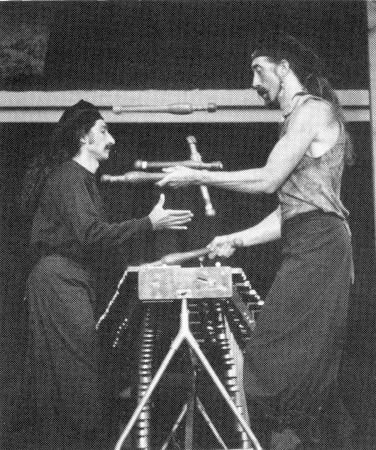 |
Page 28 Winter 1988 - 89
|
Beat
Goes On Through Karamazov's "Club" Show
by
Bob Boardman
The
Flying Karamazov Brothers (minus Randy Nelson, who's on a leave
of absence) recently premiered a new touring show called "Club.
" The production is still evolving, so the show reviewed below
(seen in early October) may differ a bit from the one coming soon to
a theatre near you.
The
house lights dim as the audience quiets to an expectant hush. For a
moment the stage is dark. Then, the sudden glare of lights and the
Flying Karamazov Brothers begin to juggle. No words or music, only
the precise unison slap of club to hand as the K's weave through an
intricate pattern they call the "squaredance. " Circling
each other in pairs, partners change as every conceivable sort of
pass is tossed. The routine flows seamlessly, held together by the
perfect rhythm of the catches. A final pass, catch, bow, blackout
and applause.
A
moment later, Ivan and Dmitri (Howard Patterson and Paul Magid) take
to the stage. "In the beginning," Ivan intones,
"there was nothing. Then there was light."
"So
there was still nothing," Dmitri quips, "but at least you
could see it!"
'Then..."
Ivan continues, "there was juggling. " And juggling is
what the Karamazov's new show is all about.
"There
are seven parts to juggling," Ivan says. The rest of the show
is built loosely (sometimes very loosely) on illustrating that
premise. The parts are solo, duet, trio, quartet, hardware, jazz and
music. But of course, there's more. In
a world full of good technical jugglers, the Karamazov's special
skill has been to mix juggling with comedy, mime, music and drama to
create that rare and elusive
commodity - an entertaining night at the theatre.
One tenet of the Karamazov method is that music equals juggling. Another is to keep the action as manic as possible. The two combine early in the first act as I van and Dmitri sing, tap dance, play "I'm forever blowing bubbles" on both nose flute and marimba while juggling the mallets and chewing gum simultaneously.
"Club"
reprises a few favorite routines and characters from past shows. The
Gamble is back, where audience members vote on three objects for
Patterson to attempt to juggle. So are Paolo Barechesto
("Animal to friends") and Igor, who team up to expand the
frontiers of science and animal husbandry. This
time, the pair subdue a cage full of rare African Killer Fireflies.
When the beasts escape, the sketch neatly segues into a visually
stunning club swinging routine. Glowing pins spin against a black
backdrop to the tune of "Flight of the Bumblebee."
After
intermission, the lights come up on a stage set like a back alley.
littered with empty bottles, cardboard boxes and random Karamazovs
sleeping off the night before.
The
drunks stir and begin a musical interlude that builds from atonal
improvisation on tuned bottles to a dramatic taiko drum climax -
juggled clubs pounding out the beat. Finally Smerdyakov (Sam
Williams) notes a peculiar flask and the memories flood back. It is,
we learn, "The Maltese Flagon."
What
follows is a deft tribute to the hardboiled detective, a bit of film
noire theatrics that combines elegant stagecraft, the usual bunch of
suspects, dialogue that crackles like a .38 automatic and...
miraculously... juggling. A restaurant scene has the K' s tossing
plates and goblets to Fyodor (Tim Furst) who stacks and balances them
on his chin.
Jazz
is the sixth part of juggling and the K 's trademark pattern is as
impressive as ever. "The basis of Jazz juggling is to do
the feed and never stop," Dmitri says. "Even if the clubs
are on the floor, the groove is still grooving..."
Later
in the routine, Dmitri and Ivan begin to argue. Smerdyakov intervenes
and the trial that follows is as worthy of the brothers Marx as
Karamazov.
The
last part of juggling is music. The Karamazovs have often blended
juggling with technology and their final routine represents the state
of several arts. The
brothers don hockey helmets. ("Why the helmet?" Dmitri
wonders. "Why
the helm not?" counters Ivan.) In each is a forehead-mounted
switch and a transmitter to send the signal to offstage MIDI devices
and produce musical notes.
They
begin to juggle the same intricate "square dance" pattern
that opened the show. Only this time, by hitting themselves in the
head with clubs, they also play the theme from the first movement of
Beethoven's Ninth Symphony. The audience responds with a well-earned
standing ovation.
"Club" is a reminder that, for all their diverse theatrical skills, juggling is still the pulse that drives a Karamazov performance. Even when the dialogue or humor or music takes center stage, the juggling is always there - like the pattern in their Jazz routine - just waiting for the clubs to make it visible. |
 |